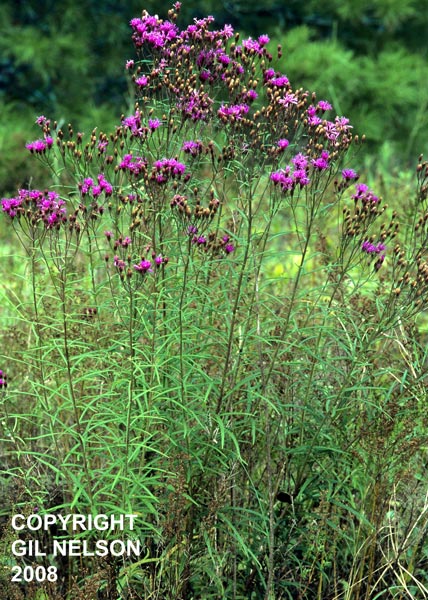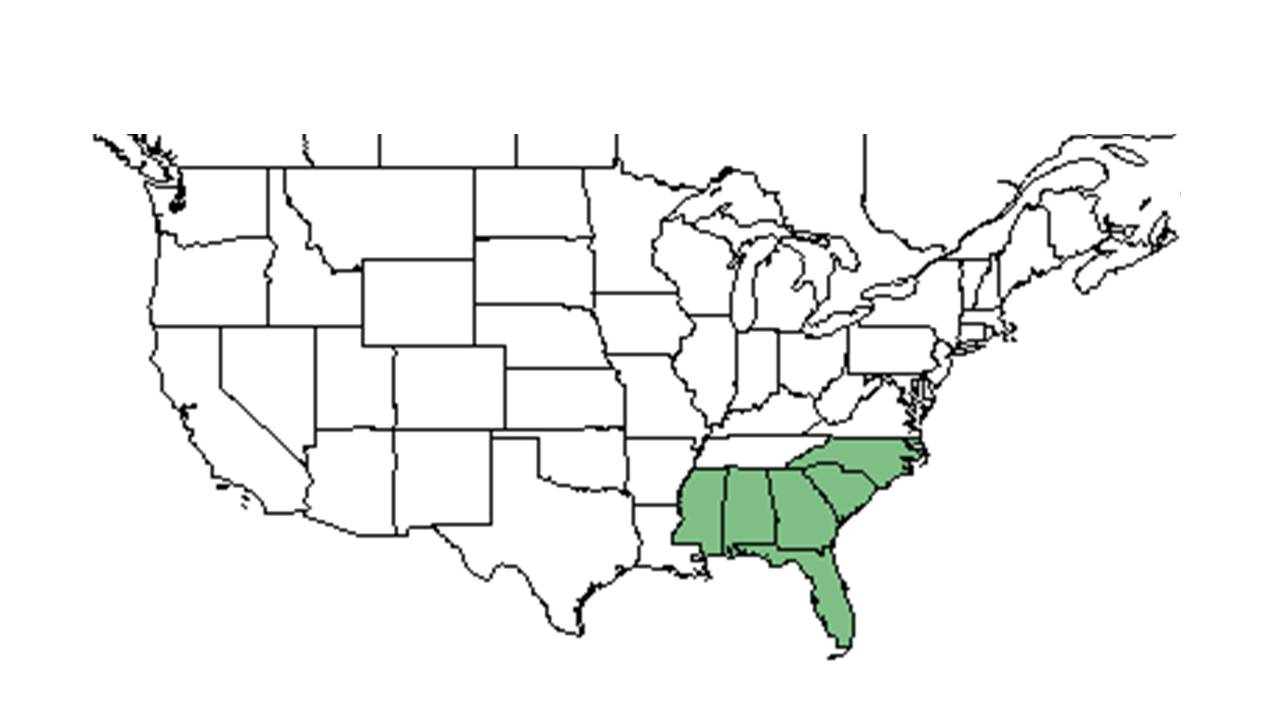Difference between revisions of "Vernonia angustifolia"
Krobertson (talk | contribs) |
|||
| Line 18: | Line 18: | ||
}} | }} | ||
| − | Common name: | + | Common name: Tall ironweed |
==Taxonomic notes== | ==Taxonomic notes== | ||
Synonyms: ''Vernonia angustifolia'' Michaux var. ''angustifolia''; ''Vernonia angustifolia'' Michaux ssp. ''angustifolia'' | Synonyms: ''Vernonia angustifolia'' Michaux var. ''angustifolia''; ''Vernonia angustifolia'' Michaux ssp. ''angustifolia'' | ||
| Line 42: | Line 42: | ||
===Fire ecology=== <!--Fire tolerance, fire dependence, adaptive fire responses--> | ===Fire ecology=== <!--Fire tolerance, fire dependence, adaptive fire responses--> | ||
It can live in areas frequently burned. <ref name=coff/> | It can live in areas frequently burned. <ref name=coff/> | ||
| + | <!--===Pollination===--> | ||
| − | |||
===Use by animals=== <!--Herbivory, granivory, insect hosting, etc.--> | ===Use by animals=== <!--Herbivory, granivory, insect hosting, etc.--> | ||
In Southeastern pine savannas, ''V. angustifolia'' was found in 6.25% of the active gopher tortoise (''Gopherus polyphemus'') burrows.<ref name=birk/> | In Southeastern pine savannas, ''V. angustifolia'' was found in 6.25% of the active gopher tortoise (''Gopherus polyphemus'') burrows.<ref name=birk/> | ||
<!--===Diseases and parasites===--> | <!--===Diseases and parasites===--> | ||
| − | |||
==Conservation and management== | ==Conservation and management== | ||
| − | |||
==Cultivation and restoration== | ==Cultivation and restoration== | ||
==Photo Gallery== | ==Photo Gallery== | ||
| Line 55: | Line 53: | ||
File:Vernonia angustifolia.jpg| <center> ''Vernonia angustifolia'' root <p> Photo by Kevin Robertson </p> <p>Pebble Hill Plantation</p> <p>2015</p> | File:Vernonia angustifolia.jpg| <center> ''Vernonia angustifolia'' root <p> Photo by Kevin Robertson </p> <p>Pebble Hill Plantation</p> <p>2015</p> | ||
</gallery> | </gallery> | ||
| − | |||
==References and notes== | ==References and notes== | ||
Revision as of 19:31, 27 September 2016
| Vernonia angustifolia | |
|---|---|

| |
| Photo taken by Gil Nelson | |
| Scientific classification | |
| Kingdom: | Plantae |
| Division: | Magnoliophyta – Flowering plants |
| Class: | Magnoliopsida – Dicotyledons |
| Order: | Asterales |
| Family: | Asteraceae ⁄ Compositae |
| Genus: | Vernonia |
| Species: | V. angustifolia |
| Binomial name | |
| Vernonia angustifolia Michx. | |

| |
| Natural range of Vernonia angustifolia from USDA NRCS Plants Database. | |
Common name: Tall ironweed
Contents
[hide]Taxonomic notes
Synonyms: Vernonia angustifolia Michaux var. angustifolia; Vernonia angustifolia Michaux ssp. angustifolia
Description
A description of Vernonia angustifolia is provided in The Flora of North America.
Distribution
Ecology
Habitat
In the Coastal Plain region, V. angustifolia can be found in sand pine scrubs, longleaf pine-wiregrass flatwoods, edges of meadows, pine-turkey oak flats, longleaf pine savannas, mixed woodlands adjacent to floodplains, annually burned pinelands, longleaf pine-sedge-andropogon savannas, slash pine-wiregrass flats, oak scrubs, second growth hardwoods, cabbage palm hammocks, annually burned upland pines [1] [2] and sandhill communities. [3] It can also be found along roadsides, power line corridors, bulldozed pine-oak scrubs, and clobbered slash pine forests. Soil types include sandy loam, loose sand, loamy sands, sandy peat[2], and Utisols [4] Associated species include Aristida, Serenoa repens, Ilex glabra, Liatris, Andropogon, Panicum, and Leptoloma cognata. [2]
Phenology
It is a fall forb. [5] Showy-flowered sandhill species. [3] Flowers and fruits June through October. [2]
Seed dispersal
According to Kay Kirkman, a plant ecologist, this species disperses by wind. [6]
Seed bank and germination
Less than 1% of V. angustifolia seeds remained viable after two years of burial. [4] So V. angustifolia does not have a short-term persistent soil seed bank and has little seed dormancy. [4]
Fire ecology
It can live in areas frequently burned. [4]
Use by animals
In Southeastern pine savannas, V. angustifolia was found in 6.25% of the active gopher tortoise (Gopherus polyphemus) burrows.[1]
Conservation and management
Cultivation and restoration
Photo Gallery
References and notes
- ↑ Jump up to: 1.0 1.1 Birkhead, R. D., C. Guyer, et al. (2005). "Patterns of folivory and seed ingestion by gopher tortoises (Gopherus polyphemus) in a southeastern pine savanna." American Midland Naturalist 154: 143-151.
- ↑ Jump up to: 2.0 2.1 2.2 2.3 Florida State University Robert K. Godfrey Herbarium database. URL: http://herbarium.bio.fsu.edu. Last accessed: July 2015. Collectors: Loran C. Anderson, Robert K. Godfrey, Nancy E. Jordan, R. Kral, K. Craddock Burks, Andre F. Clewell, P. L. Redfearn, Samuel B. Jones, Richard S. Mitchell, John C. Ogden, H. E. Grelen, James D. Ray, Jr., Gwynn W. Ramsey, E. S. Ford, C. Jackson, Robert L. Lazor, John D. Lazor, Gary R. Knight, Rodie White, R. A. Norris, R. Komarek, M. Davis, MacClendons, G. Wilder, Cecil R Slaughter. States and Counties: Florida: Bay, Calhoun, Citrus, Columbia, Duval, Escambia, Flagler, Franklin, Gadsden, Hernando, Highlands, Jackson, Lake, Leon, Liberty, Martin, Nassau, Okaloosa, Santa Rosa, Seminole, Suwannee, Taylor, Wakulla, Washington. Georgia: Baker, Coffee, Grady, Thomas. Compiled by Tall Timbers Research Station and Land Conservancy.
- ↑ Jump up to: 3.0 3.1 Heuberger, K. A. and F. E. Putz (2003). "Fire in the suburbs: ecological impacts of prescribed fire in small remnants of longleaf pine (Pinus palustris) sandhill." Restoration Ecology 11: 72-81.
- ↑ Jump up to: 4.0 4.1 4.2 4.3 Coffey, K. L. and L. K. Kirkman (2006). "Seed germination strategies of species with restoration potential in a fire-maintained pine savanna." Natural Areas Journal 26: 289-299.
- Jump up ↑ Kirkman, L. K., K. L. Coffey, et al. (2004). "Ground cover recovery patterns and life-history traits: implications for restoration obstacles and opportunities in a species-rich savanna." Journal of Ecology 92: 409-421.
- Jump up ↑ Kay Kirkman, unpublished data, 2015.
